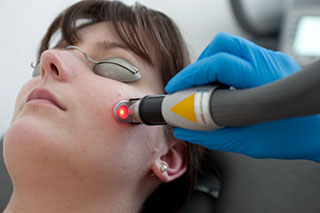
Benign skin variations
The ablative (abrasive) laser (CO2-laser) causes a vaporization of the skin and is always used, if disturbing skin structures should be specifically removed.
Larger structures are eliminated with the help of local anesthetics.
It is a very elegant method to remove skin structures without the need of a surgical operation.
Directly after the treatment a superficial abrasion is visible on the skin, which heals by the development of a scab. Mostly it takes about one week till the scab has dissolved and a fresh still reddened skin is being build. This skin should be exposed to the sun immediately. In general the treated areas heal without the formation of scars. Rarely, light spots can stay visible.
The following skin variations can be treated with the CO2-laser:
- Benign not-pigmented birth marks
- Age marks (lentigines senilis)
- Senile warts (seborrheic keratosis)
- Pre-stages of skin cancer (actinic keratosis)
- Virus warts
- Xanthomas, syringomas (debris around the eyes)
How does the CO2-laser work?
With this so called ablative (=abrasive) laser the variation of the skin can be removed in layers, by the vaporization of water containing cells.
Is the therapy with the CO2-laser painful?
Without a local anesthetic you will feel a slight pain while the treatment. Depending on the size and type of the skin variation, an adequate anesthetic can take place before the therapy.
The type and the procedure of the anesthetic can individually be planed with you.
What has to be considered before and whilst the treatment?
The skin areas should be cleaned, unmade-up and as less tanned as possible. At acute skin inflammations and infections (e.g. herpes simplex), a laser treatment will not be performed.
Whist the treatment laser goggles have to be worn.
What has to be considered after the treatment?
After the treatment a scab develops, which should not be removed and that should be kept dry. We give you a special rash cream, which can be applied to the treated area.
After about one week this scab falls off. A direct UV-irradiation (sun, solarium) should be avoided for four weeks after the treatment, to prevent the development of pigmentary abnormalities.
On sunny days (also in the winter!) the use of sun protection agents with a high protection factor (SPF 50+) is recommended. Sometimes a reddening of the skin persists at the treated area, which should also be protected by strong sunlight.


